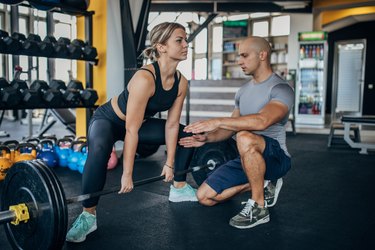
Before a muscle can grow stronger, it will incur microscopic muscle tears during a difficult workout. The healing process can last a week or longer and possibly overlap with the next workout. Understanding the type of soreness and pain you feel will help you judge how to continue your workout.
Tip
Lifting weights benefits your body in numerous ways, but it doesn't come without its challenge. As you're weightlifting, your body changes as a result of microscopic muscle tears that can cause soreness as the muscle heals and rebuilds.
Video of the Day
Microscopic Muscle Tears
Intense lifting causes several microscopic tears to form in the fiber and connective tissue of muscles, according to the Cleveland Clinic. With proper rest and nutrients, the muscles slowly rebuild over the following days, but full repair can take a week or more. For healing and growth, eat a meal of carbohydrates, protein and fat right after a workout, according to the Academy of Nutrition and Dietetics.
Video of the Day
You can also work different muscles on different days to help rest your fatigued muscles in between workouts. For example, if you work your legs on one day, the next day you could work your chest and triceps.
The Cleveland Clinic offers a sample schedule with three days of strength training on Monday, Wednesday and Friday; two days of cardio on Tuesday and Thursday; and two active rest days with light activity on weekends. You can adjust the schedule however you like to give your muscles adequate rest as you continue your exercise routine.
Weightlifting and Body Changes
As the body rebuild its muscles, it also increases muscle size, strength and capacity. Ordinarily, old tissue is discarded before new tissue is synthesized. The digestion of protein provides the raw material that can be used to synthesize new muscle.
Keep in mind that with weightlifting, the body changes you see take time to develop. According to the International Food Information Council Foundation, you can expect to see a gain of 2 to 3 pounds of muscle per month when you first begin lifting weights. After two to four years of consistent training, you may see gains of 1 to 2 pounds per month, and then 1/2 pound per month as an advanced weightlifter.
This resistance training helps to combat age-related muscle loss, too. After age 30, most people start losing lean muscle mass at a rate of 3 to 8 percent per decade. By regularly lifting weights, the benefits will become apparent as you build and hang on to more lean muscle and maintain a lean frame.
Expect Some Soreness
Although lifting weights has benefits, it comes with soreness, too. The soreness that occurs 24 to 72 hours or more after workouts was once believed to occur from the buildup of lactic acid, which the muscles produce as they use energy, but it is now believed that the soreness is the direct result of microscopic muscle tears. This soreness is known as delayed onset muscle soreness, or DOMS for short.
DOMS can cause stiffness, swelling, strength loss and pain. This is different from the burn of a workout or the deep lingering pain of an injury, which may prevent basic activity or routine tasks. Injuries can be the product of over-worked muscles and large, unhealthy tears. DOMS, on the other hand, is a sign of progress and proper weight training.
The most painful soreness occurs frequently in veterans who begin a new routine, or in beginners. In other words, the most significant number of healthy and productive tears will usually form in a muscle that is not fully acclimated to the intense training of a strenuous workout. With enough training, the muscle will gain endurance, but your training should always remain one step ahead of a comfortable workout and quick, painless recovery.
- Cleveland Clinic: "Strenuous Workouts: Try These 6 Best Recovery Tips"
- International Food Information Council Foundation: "Stronger than Yesterday: Diet and Exercise Tips for Building Muscle"
- Academy of Nutrition and Dietetics: "4 Keys to Strength Building and Muscle Mass"
- American Council on Exercise: "Don’t Be a Sore Loser - Dealing with Muscle Soreness"